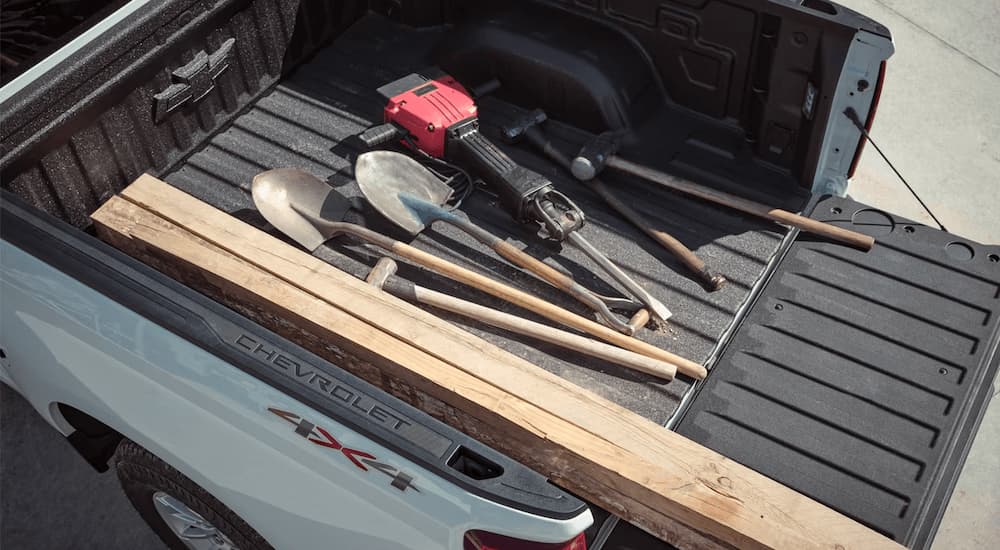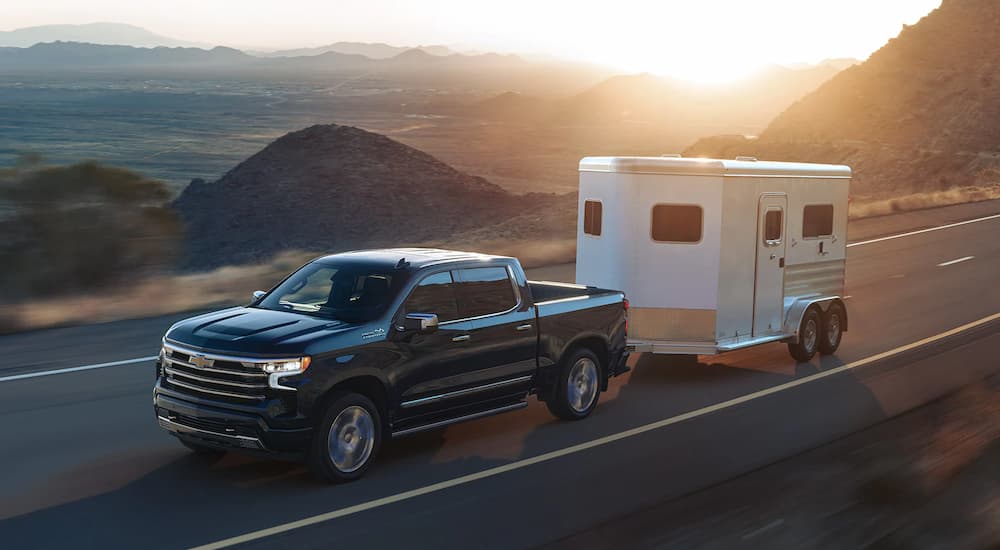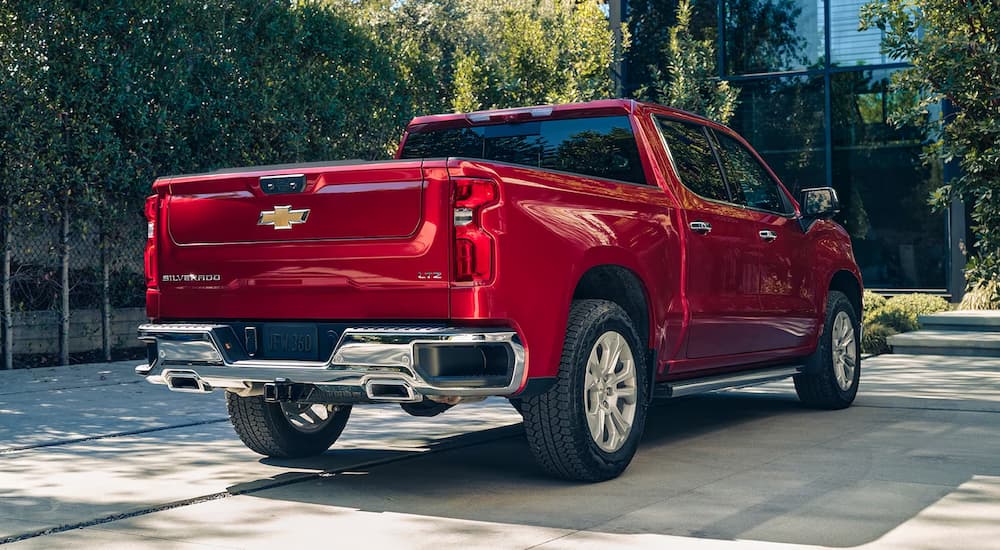When it comes to towing capacity, today’s trucks and SUVs truly run the gamut. On one end of the spectrum, you have crossover SUVS, which—due to their unibody construction—tend to max out at around 3,000 lbs. Large and midsize SUVs can up that figure to almost 9,000 lbs. But when you’re seeking the ultimate towing machine, the full-size pickup segment is where it’s at. Full-size and heavy-duty pickups are usually the go-to choice for towing thanks to their traditional body-on-frame construction, which allows these vehicles to haul a heavy load without any compromises in terms of safety and stability.
Brands like Chevy are known for producing some of the most rugged, hard-working trucks in the industry. Step inside your local Chevy Silverado 1500 dealer to find one of America’s best-selling pickups, which has stood the test of time thanks to its winning combination of performance, reliability, and towing capacity. The half-ton Silverado 1500 tops out at around 13,300 lbs, but that’s just the tip of the iceberg of the Chevy lineup. Heavy-duty options like the Silverado 2500 give drivers 18,500 lbs of towing capacity to play with, while the Silverado 3500 is the undisputed king of the road with an astounding 36,000-lb towing capacity when optioned with the Turbo-Diesel V8 engine and a gooseneck hitch.
With this kind of power on tap, it’s no wonder Chevy sells some 500,000-plus Silverado 1500s each year—but even job site stalwarts like the Silverado can use a little boost now and then. Maximizing a truck’s towing capacity is a popular path, and it can be much more affordable than you might think. Read on as we discuss some of the best towing equipment for maximizing your towing capacity—but first, a warning…
In this article, we’ll discuss maximizing your towing capacity, not increasing your towing capacity. Modern pickups are more rugged than ever before, but that’s still no excuse for exceeding a vehicle’s recommended maximum towing capacity. This rating has been carefully calculated by the truck’s engineers—and probably at least a few lawyers—and should never be ignored. A vehicle’s weight, frame, trailer hitch, suspension, engine size, torque output, and brakes all factor into how much a vehicle can tow, and exceeding a truck’s maximum towing capacity can lead to all sorts of trouble, from prematurely worn-out parts and compromised fuel economy to outright mechanical failures and tire blow-outs. Maximizing capacity is all about staying within those limits while giving your vehicle the best chance for success, allowing it to push right up against the maximum tow rating without actually exceeding it.

The Must-Haves
Upgrade Hitch: No matter what’s under the hood, a truck can only tow as much as its trailer hitch will allow. Trailer hitches are rated by weight capacity, ranging from Class I (up to 2,000 lbs) to Class V (up to 12,000 lbs). Most full-size pickups will almost always come standard with a Class III receiver hitch rated for up to 6,000 lbs, but that might not always be enough for all towing applications. A Class III hitch will be fine for towing smaller boats, campers, and utility trailers, but for larger campers, boats, horse trailers, and the like, a Class IV hitch (up to 10,000 lbs) might be called for. Luckily, the Silverado 1500 already comes with a Class IV hitch, but if your pickup isn’t quite as well equipped, an upgrade is a quick fix.
Before investing in a larger hitch, check to make sure your vehicle can accommodate the upgrade, as not all pickups are designed for heavy-duty towing. For larger trucks, a fifth wheel (30,000 lbs) or gooseneck (38,000 lbs) hitch might be the answer, but these options are overkill for half-ton pickups like the Silverado 1500, which are rated for less than half of what either of these are designed for. A weight-distribution hitch, which uses spring bars to level the load and reduce overall trailer sway, is another affordable option. A new trailer hitch will cost between $200 and $400 for Class I to IV options, and a weight-distribution hitch retails for around $300, but a fifth wheel or gooseneck can run you as much as $1,200.
Upgrade Suspension System: With all the additional weight that comes with towing and hauling, a pickup’s stock suspension might have a difficult time keeping up. The shocks, struts, and springs might not be that noticeable during the average commute or daily drive, but as soon as you get a full load in the bed or packed onto the trailer, you’ll start to feel every bump, turn, and curve like never before. Upgrading a vehicle’s suspension system with heavy-duty components allows it to better absorb the bumps associated with towing, making for a safer and more comfortable ride all around. That said, it’s not cheap, with heavy-duty suspension kits starting at $1,000 and rising all the way to $6,000, labor not included.
Upgrade Brakes: You might think that towing capacity is all about how much a vehicle can—you know—tow, but braking is often a more limiting factor. All the added weight that comes with towing can put a real strain on your vehicle’s brakes, especially when you’re coming to a full stop. Exceeding a truck’s maximum tow rating can result in all sorts of unfortunate brake-related mishaps, from warped rotors and damaged pads to boiling brake fluid. Upgrading a vehicle’s brake pads, rotors, calipers, and lines can go a long way toward increasing a vehicle’s stopping power and improving overall safety while allowing you to tow with confidence. A regular pad and rotor replacement will typically run around $300 to $600 for the entire vehicle, but you should expect to pay a little more if you’re upgrading to heavy-duty parts or are also replacing the lines and calipers.
Add Electric Trailer Brake Controller: There’s no reason to make your vehicle’s brakes do all the work when slowing down a loaded-down truck, especially if your trailer is equipped with its own brakes. Installing an electric trailer brake controller allows the driver to control the trailer’s brakes from the comfort of their cabin, taking some of the load off the vehicle’s braking system. In many states, an adjustable trailer brake controller is actually required by law when the trailer’s weight tops 3,000 lbs—but, luckily, they’re not too expensive. The electric trailer brake controller itself will run about $200, while the labor can cost anywhere between $100 and $300.
The Maybes
Remap Engine: From “smart” toasters and belts to deodorant and even litter boxes, it seems like everything has a computer in it these days. Today’s vehicles are no different, with plenty of digital wizardry packed into every nook and cranny. Of these, the electronic control unit (ECU) is the star of the show, handling some of the vehicle’s most crucial tasks and keeping everything humming along. ECUs are responsible for everything from transmission shifting to calculating the engine’s precise air-to-fuel ratio, and a little hacking can go a long way in maximizing your towing capacity. Performing an ECO “remap” can allow drivers to squeeze a few extra horses out of the engine while also subtly adjusting a vehicle’s shifting and handling to some more tow-friendly settings. Given that it’s a purely digital solution, one might think ECU remapping would come cheap but expect to pay between $400 and $1,000 for quality service.
Add Transmission Cooler: Your radiator isn’t the only component that gets a little hot under the collar when you’re towing. A vehicle’s transmission can put in a lot of work when towing or hauling a heavy load, causing the transmission fluid to reach a dangerously high temperature. Installing a transmission fluid cooler is a great way to keep temperatures down and is also a relatively affordable upgrade, with the parts going for as little as $40 plus labor.
Upgrade Radiator: Few tasks are quite as taxing on a vehicle as repeated towing sessions. From the brakes and transmission to the engine and tires, towing wears on them all, which is why it’s so important to make sure your pickup is properly outfitted for whatever towing task you might throw at it. The radiator’s job is to keep the engine and transmission nice and cool by circulating coolant throughout the system, but when you start to bump up against your truck’s max tow rating, tow for an extended period or hit a particularly steep part of your route, the radiator can have a tough time keeping up.
If this issue isn’t addressed, it can lead to some serious and costly problems, like a totaled engine caused by a broken cylinder head. Installing a larger radiator is one of the easiest ways to keep everything under the hood nice and cool, so put it at the top of your list if you’re looking to maximize your truck’s towing capacity. The typical radiator replacement will cost $400 to $700, but the price could quickly rise if extensive work is needed to make room for the upgraded unit.
Replace Intake and Exhaust: Your truck needs to breathe, especially when it’s putting in hard towing work, which is why the intake and exhaust should never be an afterthought. A larger air intake allows a vehicle to draw in more air, maximizing the internal combustion process and giving you more power to play with. On the other end of the vehicle, upgrading the exhaust allows a truck to expel its emissions as quickly as possible, reducing exhaust backup and allowing the whole system to flow freely. A typical cold-air intake upgrade runs about $200 to $300 for the part, but the exhaust is a whole other story, with prices ranging from $200 all the way up to $2,500 for a high-performance exhaust system.
Making Adjustments for Maximizing Your Towing
Before you hit the road for your next camping adventure, day at the lake, or trip to the job site, it’s important to ensure your truck is up for the task. Pickups like the Chevy Silverado 1500 certainly aren’t afraid to put in a little hard work, but even the most well-equipped truck has its limits. Consult your owner’s manual to determine your vehicle’s Gross Vehicle Weight Rating (GVWR) and Gross Combined Weight Rating (GCWR)—two numbers that describe exactly how much weight you should be towing according to the manufacturer. Starting outside of these prescribed limits is a great way to prematurely age your vehicle and could even cost you a pretty penny should your insurance company or manufacturer’s warranty department hear about the infraction.
That said, there are a few simple ways to get the most out of your truck’s towing capacity, from upgrading your brakes and suspension to a new trailer hitch, remapped engine, or performance radiator. Figure out which upgrades make the most sense for your towing demands, set a budget, and enjoy the ride knowing that you’ve set your truck up for success.





